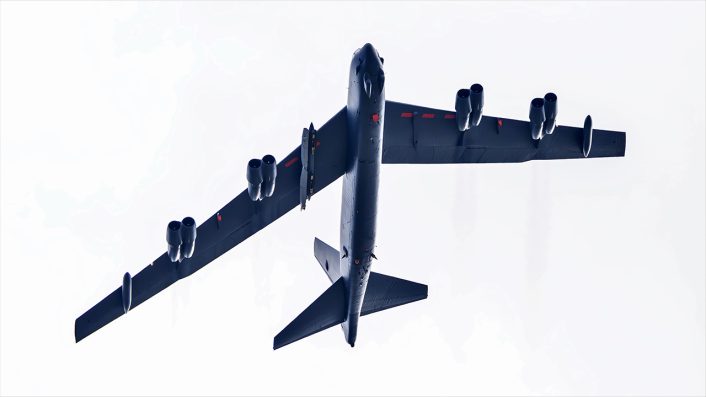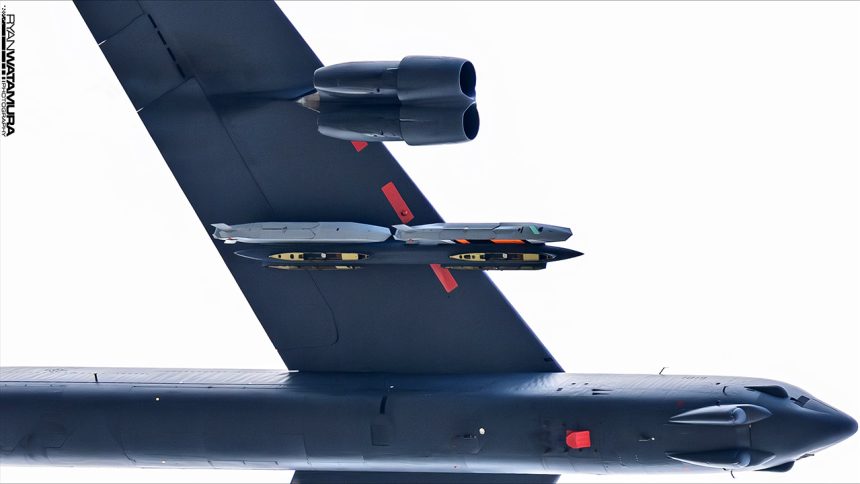New images captured by aviation photographer Ryan Watamura show a U.S. Air Force B-52H flying a low-level route over California with one external pylon loaded with the new AGM-181 Long Range Stand Off (LRSO) missile.
New photos shared with The Aviationist add another piece to the puzzle of the B-52’s ongoing integration tests with the AGM-181 Long Range Stand Off (LRSO) missile. The images, taken by aviation photographer Ryan Watamura on Nov. 5, 2025, show a U.S. Air Force B-52H Stratofortress flying a low-level route at high speed while carrying a single external pylon loaded with what appears to be the Air Force’s next-generation stealth nuclear cruise missile, the AGM-181 Long Range Stand Off (LRSO).

Watamura described the moment in a message to The Aviationist:
“I’d seen this B-52 the week before, so I was excited to hear it call in. TORCH checked into the Sidewinder Low Level mid-afternoon and entered the route at 390 kt, 2,000 ft. It rolled through with one external pylon loaded with the new weapon(s), a perfect cap to a day spent chasing passes and collecting light.”
The sighting marks the second time a B-52 is spotted carrying the AGM-181, and the new photos complement the imagery published last week of a B-52H with test markings flying with a similar payload over Edwards Air Force Base, which hinted at ongoing integration and aerodynamic testing of the LRSO under the bomber’s external pylons.
Once again, although the U.S. Air Force has not publicly acknowledged the weapon, the new images provide strong visual confirmation that its shape and configuration are almost identical to the official rendering of the AGM-181 LRSO, reinforcing the identification made from earlier sightings.

Moreover, the B-52 carrying the LRSO sported the distinctive START compliance fins on its tail, which identify it as a nuclear-capable aircraft under the New START treaty. These fins are used to distinguish bombers equipped for nuclear missions from conventional-only variants during arms-control inspections, further reinforcing the link between this specific airframe and the testing of a strategic, nuclear-delivery weapon like the AGM-181 LRSO.
The nuclear version has a fin on each side of rear fuselage
The non-nuclear version does not https://t.co/EOqLS8Oeba
The fins are used as external features to identify the nuclear version under the New START treaty. There are 46 nuclear and 41 non-nuclear B-52s. https://t.co/JU49tEcapy pic.twitter.com/QcW13HEuiO
— Hans Kristensen (also on Bluesky) (@nukestrat) August 26, 2022
The AGM-181 LRSO is expected to replace the aging AGM-86B Air-Launched Cruise Missile, offering a stealthier and more survivable stand-off capability for the U.S. strategic bomber fleet. Its development is part of the broader B-52 modernization effort, which also includes new radar, engines, and communications upgrades.
The weapons are installed on the outer attachment points of a Multiple Ejector Rack (MER), which can hold up to six weapons (not six AGM-181s). The MER is also used by the B-52H to carry multiple types of ordinance.
Here’s what we wrote about the LRSO in our previous article on the new weapon:
The AGM-181 Long Range Standoff (LRSO) Cruise Missile is a long range survivable standoff weapon capable of delivering lethal nuclear effects on strategic targets, which will replace the currently fielded AGM-86 Air Launched Cruise Missile (ALCM). The LRSO will be integrated on both the B-52 Stratofortress and B-21 Raider bomber aircraft.
The LRSO weapon system will be capable of penetrating and surviving advanced Integrated Air Defense Systems (IADS) from significant standoff ranges to prosecute strategic targets in support of the Air Force’s global attack capability and strategic deterrence core function.
The LRSO is a priority for the Air Force as the U.S. is working to modernize its nuclear triad, and has been defined as a critical capability for the B-21 Raider. The new stealth bomber is set to be equipped with three nuclear weapons: the AGM-181 LRSO cruise missile and the B61-12 and B61-13 bombs, with the latter used exclusively by the Raider.
As the weapon is being tested in secret, last year the Air Force’s then Service Acquisition Executive Andrew Hunter told the Senate Committee on Armed Services that the program is on track. “It is tracking well, the program is definitely on track to meet its timeline and deliver to the warfighter any day and we’re also doing well on cost for that program as well,” said Hunter.
In 2020, the Air Force selected Raytheon as the prime contractor for the program and, a year later, LRSO entered Engineering, Manufacturing, and Development (EMD). In 2022, it was revealed that LRSO conducted nine successful major flight tests demonstrating its ability to safely separate from the B-52H aircraft, as well as weapon flight surface deployment, engine operations, flight control actuations and controlled flight.
Initially, the Air Force and Congress have also been discussing potential acquisition of conventionally armed variants of the missile. However, it was later decide to not pursue a conventional warhead version of the LRSO, with the Air Force now looking to the AGM-158B JASSM-ER (Joint Air-to-Surface Standoff Missile-Extended Range) and the AGM-158D JASSM-XR (JASSM-Extreme Range) to fill the requirement for a conventional air-launched cruise missile.
The Air Force mentioned in its fact sheets that a total of 1,715 of AGM-86B missiles were produced, although in 2007 the service announced the decision to reduce the inventory to 528 missiles. The weapons are set to be retired by 2030, replaced by approximatively 1,020 AGM-181s, according to The War Zone, quoting a Pentagon acquisition report.
In late 2022, the program’s total cost was estimated in about $16 billion, with the most recent estimates mentioning a cost per unit of about $14 million, instead of the expected $10 million, as reported in 2024 by Air and Space Forces Magazine. A low-rate initial production decision is expected in fiscal year 2027.
As we observed in our previous coverage, when highly classified assets like this are seen in plain daylight, it is often not by coincidence. The fact that the weapon was flown at low altitude in clear conditions may indicate that the U.S. Air Force wanted it to be seen, as part of a subtle demonstration of capability following recent strategic messaging from Moscow.
The Aviationist will continue to track further sightings and imagery related to the B-52’s evolving test campaign and its integration with the next-generation nuclear cruise missile program.

Thanks to Ryan Watamura for sharing the photos with us. Make sure to follow on Instagram for more here!









